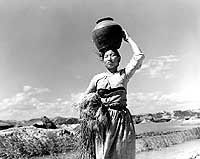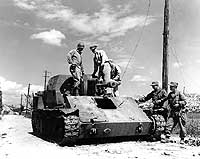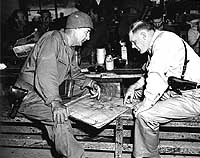
After the Inchon Invasion on 15 September 1950, U.S. Marines quickly moved on Seoul. Though fighting was sharp, the South Korean capital city was liberated by late September. Marines and the Army units of Tenth Corps also cleared areas to the north, east and south of Seoul, supported by Navy and Marine Corps planes and, to the extent targets remained within range, by naval gunfire.
Meanwhile, the Eighth Army in the Pusan Perimeter attacked the surrounding North Koreans, who began to retreat after a few days. As the retreat became increasingly disorganized, U.N. ground forces moved rapidly toward Seoul, and beyond, in spearheads up the western and central parts of the country. On the east coast, South Korean troops pushed vigorously northward, assisted by ships' guns.
As with the summer's North Korean onslaught, the U.N. ground offensive produced massive civilian displacement, as some people tried to get out of the way of fighting and others followed the armies to return to homes they had fled earlier. The disintegration of the North Korean army also left large numbers of armed Communists in the hills of south and central Korea, where they remained a constant military threat for many months to come.
South Korean soldiers crossed the 38th Parallel into North Korea on 1 October, with other U.N. forces making the move a week later, after receiving the General Assembly's blessing. Wonsan was captured by 13 October as part of the east coast push that included an unopposed amphibious operation at Iwon in late October and reached as far as Chongjin in mid-November. Pyongyang, the enemy capital, fell on 19-21 October and the Navy opened a new port at nearby Chinampo a few weeks later. As the Eighth Army and Tenth Corps moved up toward the Yalu, advanced ROK and U.S. elements briefly reached the river in a few places.
However, Chinese troops had begun to cross the Yalu on 16 October, concealed by rugged terrain, weather and smoke from forest fires. They first clashed with South Koreans on the 25th. The next day, the Chinese hit the ROKs hard in several places. On the ground and in the air, other U.N. forces had sharp fights with the new enemy in early November, but the Chinese then broke off most contact and were hard to find for nearly three weeks. Very concerned by the initial Chinese actions, then emboldened as they seemingly disappeared, General MacArthur ordered his forces forward once again. The UN offensive resumed on 24 November, making progress in the west and east. In the center, however, the South Koreans ran into far more than they, or General MacArthur's staff, expected.
This page features pictures of and related to land operations during the U.N. offensive period of the Korean War, from 15 September to 25 November 1950.
For views of the liberation of Seoul and other ground operations
in that vicinity, see:
Land operations around Seoul, September-October
1950.
For visual coverage of other aspects of the September-November
United Nations' offensive in Korea, see:
For a precis of our Korean War images, and links to more
comprehensive pictorial coverage of that conflict, see:
| If you want higher resolution reproductions than the Online Library's digital images, see: How to Obtain Photographic Reproductions. |
Click on the small photograph to prompt a larger view of the same image.
|
Photo #: 80-G-420666 Russian-built North Korean SU-76 Self-Propelled Artillery Piece Is examined by U.S. personnel, including a Navy Commander, after it was disabled by United Nations' forces during early fighting in the Korean War. This 1943-44 vintage vehicle had a crew of four and mounted a 76.2 millimeter gun with 62 rounds of ammunition. The hole in the angle of the bow glacis plate may have been made by the projectile that knocked it out of action. Other damage is visible just above the gun barrel. Official U.S. Navy Photograph, now in the collections of the National Archives. Online Image: 115KB; 740 x 615 pixels Reproductions of this image may also be available through the National Archives photographic reproduction system. |
 |
|
Photo #: 80-G-420809 Commander L.E. Hubbell, USN,, Operations Officer of USS Helena (CA-75), (right) Confers with Lieutenant Colonel Rollins S. Emmerich, U.S. Army, at Korean Military Advisory Group Headquarters, 19 October 1950. Helena was then providing gunfire support for the United Nations' forces offensive in Korea. Note Cdr. Hubbell's shoulder holster. Official U.S. Navy Photograph, now in the collections of the National Archives. Online Image: 128KB; 740 x 610 pixels Reproductions of this image may also be available through the National Archives photographic reproduction system. |
 |
|
Photo #: 80-G-420665 Korean refugee woman Carries her belongings in a jug on her head, while fleeing from Pohang, South Korea. Original photo is dated 17 October 1950. Official U.S. Navy Photograph, now in the collections of the National Archives. Online Image: 87KB; 740 x 615 pixels Reproductions of this image may also be available through the National Archives photographic reproduction system. |
 |
|
Photo #: 80-G-420658 Korean refugees On the road, probably in the Pohang area in October 1950. Note hand-barrows used to carry their belongings. Official U.S. Navy Photograph, now in the collections of the National Archives. Online Image: 144KB; 740 x 615 pixels Reproductions of this image may also be available through the National Archives photographic reproduction system. |
 |
For views of the liberation of Seoul and other ground operations
in that vicinity, see:
Land operations around Seoul, September-October
1950.
For visual coverage of other aspects of the September-November
United Nations' offensive in Korea, see:
For a precis of our Korean War images, and links to more
comprehensive pictorial coverage of that conflict, see:
| If you want higher resolution reproductions than the Online Library's digital images, see: How to Obtain Photographic Reproductions. |
3 January 2000